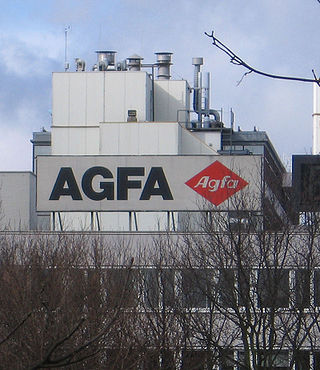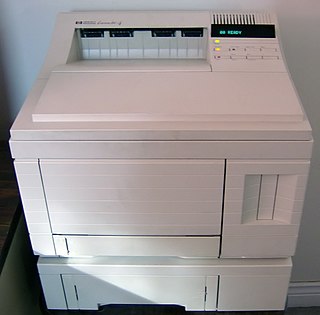
PostScript is a page description language and dynamically typed, stack-based programming language. It is most commonly used in the electronic publishing and desktop publishing realm, but as a Turing complete programming language, it can be used for many other purposes as well. PostScript was created at Adobe Systems by John Warnock, Charles Geschke, Doug Brotz, Ed Taft and Bill Paxton from 1982 to 1984. The most recent version, PostScript 3, was released in 1997.

The LaserWriter is a laser printer with built-in PostScript interpreter sold by Apple, Inc. from 1985 to 1988. It was one of the first laser printers available to the mass market. In combination with WYSIWYG publishing software like PageMaker, that operated on top of the graphical user interface of Macintosh computers, the LaserWriter was a key component at the beginning of the desktop publishing revolution.
HP-GL, short for Hewlett-Packard Graphics Language and often written as HPGL, is a printer control language created by Hewlett-Packard (HP). HP-GL was the primary printer control language used by HP plotters. It was introduced with the plotter HP-9872 in 1977 and became a standard for almost all plotters. Hewlett-Packard's printers also usually support HP-GL/2 in addition to PCL.

Ghostscript is a suite of software based on an interpreter for Adobe Systems' PostScript and Portable Document Format (PDF) page description languages. Its main purposes are the rasterization or rendering of such page description language files, for the display or printing of document pages, and the conversion between PostScript and PDF files.

Agfa-Gevaert N.V. (Agfa) is a Belgian-German multinational corporation that develops, manufactures, and distributes analogue and digital imaging products, software, and systems.

Typesetting is the composition of text for publication, display, or distribution by means of arranging physical type in mechanical systems or glyphs in digital systems representing characters. Stored types are retrieved and ordered according to a language's orthography for visual display. Typesetting requires one or more fonts. One significant effect of typesetting was that authorship of works could be spotted more easily, making it difficult for copiers who have not gained permission.
In computers, a printer driver or a print processor is a piece of software on a computer that converts the data to be printed to a format that a printer can understand. The purpose of printer drivers is to allow applications to do printing without being aware of the technical details of each printer model.

LaserJet as a brand name identifies the line of laser printers marketed by the American computer company Hewlett-Packard (HP). The HP LaserJet was the world's first commercially successful laser printer. Canon supplies both mechanisms and cartridges for most HP laser printers; some larger A3 models use Samsung print engines.
Ikarus is a type design and production software developed by URW and Brendel Informatik foundries, for converting existing typefaces and logos into digital format for use on computer driven printing, plotting and sign cutting devices.

Monotype Imaging Holdings Inc., founded as Lanston Monotype Machine Company in 1887 in Philadelphia by Tolbert Lanston, is an American company that specializes in digital typesetting and typeface design for use with consumer electronics devices. Incorporated in Delaware and headquartered in Woburn, Massachusetts, the company has been responsible for many developments in printing technology—in particular the Monotype machine, which was a fully mechanical hotmetal typesetter, that produced texts automatically, all single type. Monotype was involved in the design and production of many typefaces in the 20th century. Monotype developed many of the most widely used typeface designs, including Times New Roman, Gill Sans, Arial, Bembo and Albertus.
A computer font is implemented as a digital data file containing a set of graphically related glyphs. A computer font is designed and created using a font editor. A computer font specifically designed for the computer screen, and not for printing, is a screen font.

PageStream is a desktop publishing software package by Grasshopper LLC currently available for a variety of operating systems including Windows, Linux, and macOS. The software was originally released under the name Publishing Partner for the Atari ST in 1986 by Soft-Logic Publishing Corporation.
Printer Command Language, more commonly referred to as PCL, is a page description language (PDL) developed by Hewlett-Packard as a printer protocol and has become a de facto industry standard. Originally developed for early inkjet printers in 1984, PCL has been released in varying levels for thermal, matrix, and page printers. HP-GL/2 and PJL are supported by later versions of PCL.

The HP LaserJet 4 is a group of monochrome laser printers produced in the early to mid-1990s as part of the LaserJet series by Hewlett-Packard (HP). The 4 series has various models, including the standard LaserJet 4 for business use, the 4L for personal use and the 4P for small businesses. Additional models included the 4Si model, created as a heavy-duty business printer, and the 4V model, a B-size printer for desktop publishing and graphic artists. There are also PostScript variants of these machines with the '4M' designation, where M stands for, but is not limited to, usage with an Apple Macintosh. Hewlett-Packard also released an upgraded version of the LaserJet 4/4M known as the 4 Plus ('4+')/4M Plus ('4M+').
Bitstream Font Fusion is a small, fast, object-oriented font engine written in ANSI C capable of rendering high-quality text on any platform, any device, and at any resolution. The entire source code is portable, optimized, and executes independent of operating system and processor. The font engine is capable of rendering 2,400-3,300 characters per second on a 100 MIPS CPU.
Compugraphic Corporation, commonly called cg, was an American producer of typesetting systems and phototypesetting equipment, based in Wilmington, Massachusetts, just a few miles from where it was founded. This company is distinct from Compugraphics, a British company founded 1967 in Aldershot, UK that specializes in the production of photomasks used in the production of integrated circuits. In 1981, it was acquired by European competitor Agfa-Gevaert, and its products and processes merged into those of Agfa. By 1988, the merger was complete and the Compugraphic brand was removed from the market.
Amiga support and maintenance software performs service functions such as formatting media for a specific filesystem, diagnosing failures that occur on formatted media, data recovery after media failure, and installation of new software for the Amiga family of personal computers—as opposed to application software, which performs business, education, and recreation functions.
Steven R. Matteson is an American typeface designer whose work is included in several computer operating systems and embedded in game consoles, cell phones and other electronic devices. He is the designer of the Microsoft font family Segoe included since Windows XP; of the Droid font collection used in the Android mobile device platform, and designed the brand and user-interface fonts used in both the original Microsoft Xbox and the Xbox 360.
In computing HP Roman is a family of character sets consisting of HP Roman Extension, HP Roman-8, HP Roman-9 and several variants. Originally introduced by Hewlett-Packard around 1978, revisions and adaptations were published several times up to 1999. The 1985 revisions were later standardized as IBM codepages 1050 and 1051. Supporting many European languages, the character sets were used by various HP workstations, terminals, calculators as well as many printers, also from third-parties.
Traditional Arabic is an Arabic naskh-based typeface first developed by Monotype as Series 589 in the spring of 1956. It featured a system of interlocking sorts to allow for the diacritics to properly display over the letters they modify.








